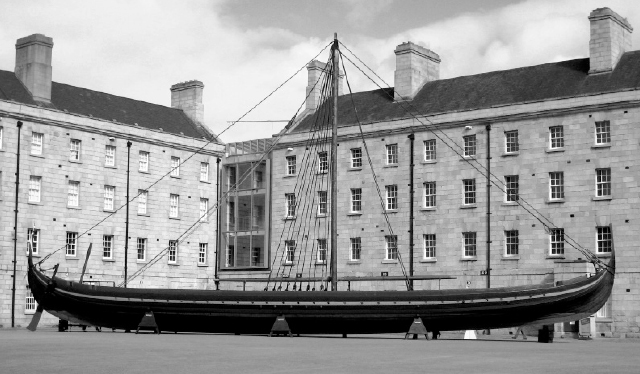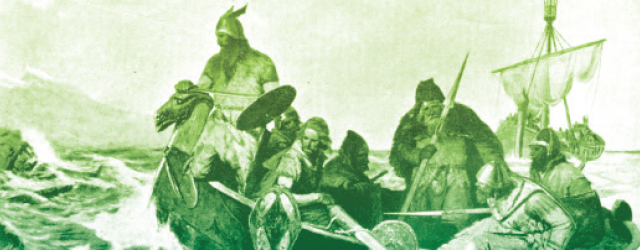By Carmel McCaffrey
Interest in the Vikings and their escapades throughout Europe has grown in recent years mostly because of popular TV dramas – but much of what is written and described in these dramatizations is more myth than historic fact. Although at first these raiders from the north caused mayhem and havoc in Ireland, resistance grew and their experience in Ireland ultimately proved to be anything but easy. Yet the fierce warriors who descended from northern Europe did leave their mark wherever they went. At first, the raids were hit, grab and run episodes but eventually the Vikings established settlements in Ireland that played an important part in the development of Irish society.
The first Viking attacks on Ireland occurred in the year AD 795 when Viking raiders were recorded arriving on Rathlin Island off the coast of County Antrim along the northern coast. They then sailed around the coast of Donegal and attacked the monastic island of Inishmurray, four miles off the Sligo coast. Their object was plunder and they concentrated on where the wealth was, and this was the monastic settlements. These early attacks had a shattering effect on Ireland’s small island coastal communities who were completely unprepared for these raiders. In these early attacks surprise proved to be a significant and fearful weapon. The Viking raiders thought little of killing all who got in the way of their plunder. Irish annals record the fear and horror at these moments. One attack off the Kerry coast on the remote and small island of Skellig Michael resulted in what the annalist recorded in AD 824 as “Etgal, the Abbot of Skellig was carried off by the heathens and died soon after of hunger and thirst”. This type of attack on a remote place might have fed the idea that the entire country was savaged and without any indigenous defenses, but that is not the full story of the Vikings in Ireland.
Monasteries in Ireland were not as we understand monasteries today. The ‘monks’ were not at all what we would nowadays know as secluded, unarmed, vulnerable men. Monasteries were rich, headed by families, and quite worldly. The married abbots passed the monastery along to their sons. They had great wealth and were concerned about defending their monastery and wealth. The larger monasteries had troops and when disputes arouse between them it was not unusual for monasteries to go to battle with each other. The Irish annals record more than 20 monastic pitched battles fought in the eighth century – long before the Vikings arrived in Ireland.
The Irish chieftains and kings showed a lot of resistance to Viking attacks with counter attacks. Irish kings battled with the Vikings and successfully resisted their incursions into inland Ireland. Even in the initial stages of the Vikings’ hit and run raids they came up against defeats. As early as 811 there was a massacre of Viking raiders by the Ulaid dynasty in the north of the country. The following year the Vikings were slaughtered in the southern part of the country in Munster by the Éoganacht dynasty.

Munster and Leinster chieftains and kings prevented the Vikings from inland incursions, but the coast was undeveloped and the Vikings established settlements there. The Irish tuatha [family groups] lived in inland communities so it was it was easier for the Vikings to establish their settlements along the southwest and south coasts, including Limerick, Cork, Waterford and Wexford and on the east in Dublin. Dublin became the center of Viking power in Ireland and on the Irish Sea.
In 968 when the Vikings attempted to go inland from Limerick and take Cashel [the seat of the Munster kingship] they were badly defeated at the Battle of Sulcoit near modern day Kilkenny. As Irish scholars point out, the same Viking warriors who were defeated at this battle were successful a short time later in going inland in England and establishing themselves at York. Irish resistance proved more successful against the Vikings than the English. Viking expert Pat Wallace of Ireland’s National Museum makes the point that Viking conquests in Ireland were limited and peripheral while large parts of England and Scotland were relatively easily taken.
In the case of the north of Ireland the Uí Neill and Ulaid dynasties were so powerful there that even the coast was not open to the Vikings. The Vikings were unable to establish anything of permanent significance in the north or northwest where the powerful Uí Neill dynasty – of the high kingship – held power. The northern kings were traditionally more powerful and more influential than the other Irish kings. The Uí Neill dominated the region of Tara in modern day County Meath and everything north of that. The Vikings tried to make incursions into Tara. They didn’t succeed and were badly defeated in AD 980 at the Battle of Tara. This decisive defeat for the Vikings was the last attempt they made to go inland into Ireland. Their plan to go from Dublin into Tara and Meath and possibly farther north was permanently halted.
Because the Vikings failed to dominate Irish life, Dublin and the other Viking towns came to resemble Irish kingdoms. A form of co-operation developed between the Vikings and some Irish kings. The Dublin Vikings were forced to pay tribute to Irish kings as the price for keeping some independence. The ultimate demise for Viking power in Ireland came at the Battle of Clontarf on Good Friday 1014 when the new Irish High King, Brian Boru, led a mostly Irish army and took on the Dublin Vikings. Brian was a new force in Ireland. He was trying to unite the country politically and make the high kingship a more powerful position. He saw the Dublin Vikings’ quasi independence as a threat to this. The Dublin Vikings had an alliance with the Leinster Irish kings and sought their help. Overseas Vikings from the Orkneys and the Isle of Man came in ships along the Dublin coast to Clontarf, just north of the city, in order to invade and take on Brian’s army. The Vikings saw Dublin as pivotal to their power base on the Irish Sea. Ultimately however, the Vikings were defeated. By the end of that very long day the forces of Brian Boru were victorious. By dint of sheer strength, Boru’s forces had pushed the invaders and the Dublin Vikings back into the sea. Many of them were drowned in the sea and in the River Tolka which was at full tide. The Viking leader of Denmark and Brodar of the Isle of Man were killed, as was the Earl of Orkney. Those Vikings not pushed into the sea fled the battle site and were chased to the gates of Dublin City. Many were slain by the pursuing Irish army before they reached the city. Summing it all up the Inisfallen annalist wrote that “the foreigners of the western world were slaughtered.” It was an amazing military victory for the Irish. Ireland had never seen a battle like it before.
Remaining outside of the Roman Empire the Irish had never experienced large scale European battles. Tragically, Brian Boru was killed towards the end of the day but victory nevertheless went to him and his forces. Never again did the Vikings attempt to invade Ireland.
Although the Vikings never managed to get any real power in Ireland, they created a huge legacy. They founded the first Irish coastal cities and established Dublin as the capital and economic center of Ireland: a position that the city of Dublin holds to this day. Those Vikings who had settled in Ireland remained. Many Irish were drawn to the wealth of the new towns created by the Vikings and came also to live in them. Irish art reflected this fusion of Irish and Viking. The magnificent twelfth century Cross of Cong is a prime example of this synthesis. Viking contribution to Irish life is beyond doubt. They are an important part of the history and development of Ireland.
For further information on the Vikings in Ireland and Brian Boru consult Carmel McCaffrey’s book In Search of Ancient Ireland and the PBS/RTE TV series that accompanies the book.

